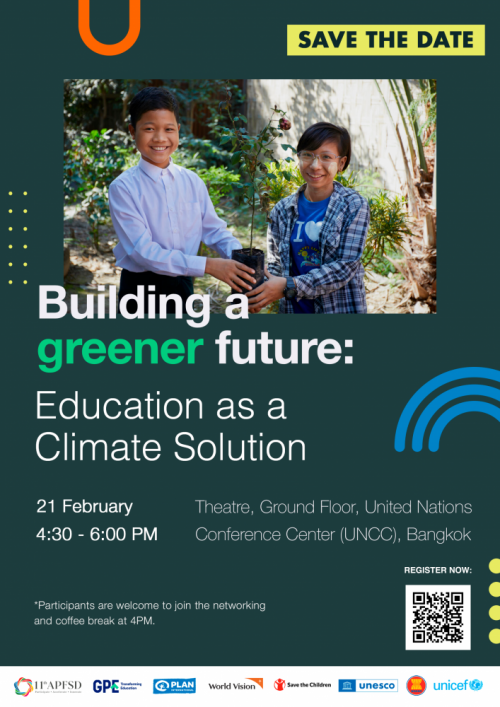At the Asia-Pacific Forum on Sustainable Development held earlier this year, GPE co-organized with partners a side event on Building a greener future: Education as a climate solution. Here are three key takeaways from the event:
244 million children will not set foot in a classroom this year, while 1 billion children are at extremely high risk of suffering from the climate crisis, impacting their health and ability to learn. Mao Rima, a World Vision Children and Youth Club leader from Cambodia, shared how her community was affected by flash flooding, forcing children to stay home from school and their parents to stay home from work. Monika Budha, a youth representative from Plan International Nepal, highlighted how heavy rainfall caused disruptions and affected her studying. “Climate change is impacting girls first and worst, particularly in the poorest countries which are least responsible for climate change. In Nepal students are losing up to 3 months of education due to climate disasters.” Yet, young people are at the forefront of climate action in their communities, when they are empowered with the knowledge and support to do so. Mao and Monika’s work includes raising awareness about climate change with children and their communities through street plays and games, identifying vulnerable areas in villages, and promoting practical solutions like reusing wastewater for irrigation and planting trees in schools. Mao asks that the leaders invest and support youth climate action. “Include us in national and international climate discussions. We have ideas and experiences we want to share, as well as fresh perspectives.” At COP28, 40 countries adopted the groundbreaking Declaration on the Common Agenda for Education and Climate Change. This was the first time that the critical link between education and climate action was acknowledged at a global political level and recognized as being foundational for a resilient and sustainable future. In the Asia-Pacific region, Thailand, Bangladesh, Pakistan, Laos, Uzbekistan and Tonga adopted the Declaration. In the Asia-Pacific region, several initiatives are underway: Despite this encouraging progress, financing emerged as a key challenge to taking up meaningful climate action, along with the need to build capacity of communities, teachers and policy makers and increasing collaboration between the education and climate sectors. These are some of the needs GPE initiatives are aiming to fill. In partnership with Save the Children, UNESCO and the International Institute for Educational Planning (IIEP), GPE is expanding its technical support to 22 of the most climate-vulnerable countries through the Climate Smart Education Systems Initiative. The initiative aims to strengthen countries' capacity to integrate climate change into their education sector plans, budgets and strategies. GPE is also partnering with the Green Climate Fund and Save the Children on Building the Climate Resilience of Children and Communities through the Education Sector (BRACE) – the first ever collaboration between the global funds for climate and education. BRACE aims to accelerate community resilience by investing in climate adaptation for the education sector. It also provides technical support to ready more countries to access climate finance for comprehensive school safety strategies.
1. Children and young people are disproportionately affected by the climate crisis, but also at the forefront of climate action
2. We are seeing growing political will for climate smart education systems. This has begun to translate into policies and programs
3. More collaboration, capacity and financing are needed













